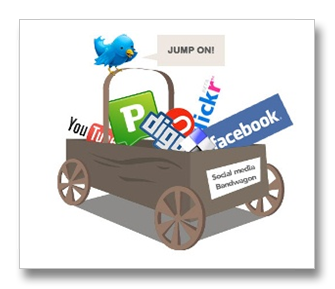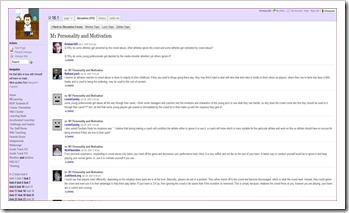The SSATs opening question (above) was then expanded to include a review of the use of social media technologies
- In the classroom
- For school management and parental engagement
- For professional development
We were advised to write ‘a number of concise paragraphs, perhaps one on each use of social media mentioned above??’ Which, in writing this article, I now realised was an error. Those ‘mentioned above’ are in fact settings and not examples, of social media?? But we know what the SSAT are looking for, plus ‘one or more (paragraphs) outlining how you overcame any resistance or barriers to the use of social media.’ Well the barriers to social media certainly exist and I haven’t managed to get around them yet! In summary, a very attractive opportunity and a good reason to bring my thinking together on this thorny issue.
So, here is my formal response…
IMHO there is sufficient educational richness in Twitter alone, to write an article under each setting, without even touching upon the even broader headline of social media. Social being the key word. For the record and what part of the WWW is not social (out of school beyond the filters?) Almost every web resource and website enables comments, a feedback box, RSS or ‘contacts us’ form, including the vast majority of school websites.
So, refocus. Twitter not in my the classroom.
Arrrhh the hallowed grounds of the ‘classroom.’ Almost all known social media / networking sites are blocked County wide, that is IMing or chatrooms to those of us older than Google (12). Bit of an official dead end for students (unless using their phones or deviant tactics). Teachers can often access social tools (that’s fair) and can therefore share its influence and many teachers do but that’s like demonstrating a painting technique in Art but withholding the student’s brushes.
How versatile is Twitter? or 140 characters. You would think that this limitation would hold you back? It does. It makes you think and write more efficiently (note, I didn’t say correctly). The teaching opportunities of Twitter are only limited by your creativity / efficiency. Crowd sourcing ideas / opinions from your network, potentially anyone on the planet. Not bad for starters. MFL, send a Twitter in Spanish to which the students respond in English? Or translate? Lesson feedback, #likes and #dislikes (Yes, I do realise you could just ask the students but does everyone get a chance to reply? No.) Paragraph reviews, chapter reviews, book reviews?! Now there is a precise challenge. Instead, write a book, ok a story maybe, collaboratively, twittories adding 140 characters to the story at any given time. Chinese twhispers. Follow a famous Tweeter, are they who they say they are? Ask a famous Tweeter? Tweet as if you were… Controversially, as a conversation / home study tool? Or a little grandeur, Romeo and Juliet tweet-a-thon (hyperlinked if online) (link if offline http://www.suchtweetsorrow.com/).
Twitter is being used from ‘kindergarten’ to the Lecture hall and if that not enough breadth, here are 100 ways to teach with twitter. (There may be some duplication, but come on, I think I did quite well with 15 or so and we have not touch any 3rd party tools (extras or add-ons). I can’t resist, just one idea. Every Easter my father in-law hides Easter eggs. He then created blurred or very close-up photos of the hiding places. The children have to find the treasure, using just the visual clues. What about posting Twitpics – easy from any smart phone. ‘Where am I?’ to engage students in preparation for visits or whilst out at an educational visit? Or for those back at the ranch?
As for social media in the classroom – lets start with the myriad of VLE tools, forums, chats, wikis and blog, plus questionnaires, surveys and all things embeddable. Moving onto Mind-mapping, data-mapping, Micro Mobbing, Wallwish(er)ing, Instant Messaging (IM-ing), real-time quizzing, Google Docs, Google Apps, Microsoft Web Apps and there lies a book chapter. Take a breath. Social book-marking, Music streaming, video sharing, photo sharing, online gaming, Gaming? Isn’t the Wii social? Geo-caching, VOIP, forums, voting, e-pals…. and of course social networking site such as NING and Gr.oups, ELGG, Facebook (or not to Facebook) and the soon to be Diaspora . What is worrying, is I know that I have only included those social tools I have tried and tested or tools that I am waiting for an opportunity to experiment with, with the help of students.
Why should teachers investigate and use these tools? In my early years of teaching, my mentor suggested I listened to the charts once in a while, ‘to help me get to know my students.’ Oasis and Blur battled it out in the charts, and I got a little insight into my students ‘out of education’ interests. I occasionally let students set up class-sourced play lists and they got to know a little about one another. Working with social media is not just about ‘using’ tools, but engaging with students. I have witnessed all male PE groups, chart monstrous mind maps in webare tool Bubbl.us, boys who hardly write a stitch and only when if they brought writing equipment to class. I observed lessons where real-time or IM (fast to respond) quizzing grabbed the students focus, a potent mixture of something new, technology, competition and instant feedback. Back in 2007, I experimented with wiki’s and the discussion boards behind the pages. A single Sports class contributing 100+ posts, some 1000+ views, debating the personality of elite athletes, well footballers mainly. Students posting, evaluating, challenging and defending their opinions and the opinions of class peers. I admit it, the spelling could be improved but thinking was sharp.
IMHO, social media tools are not an essential ingredient for an outstanding learning experience but they can enhance / diversify / transform / expand / focus / extend / motivate / ripen the learning experience, heighten the emotional connect with the learning and therefore magnify the learning influence of the lesson.
That is where we are now, where are we going? Social mobile tools are on the horizon. Geo-location activities are already social and already mainstream, Foursquare and so on. How will they be re-designed for educational use I don’t know? Google backed SCVNGR has great potential? Will Augmented Reality, RFID or QR codes have both a social and education influence? Shall we at least get Twitter unblocked first.
(For the record, I understand that child safety is extremely important to parents, schools and LEAs, and some filtering is necessary, however I also believe that educating our students is as important as protecting them.)



